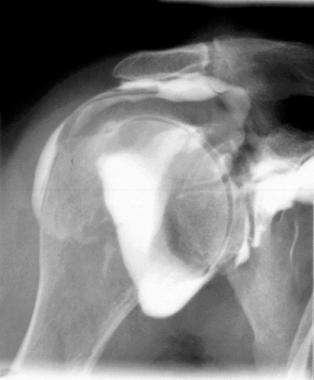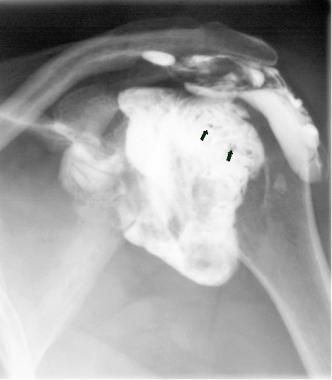

Impingement syndrome and rotator cuff disorders are common causes of shoulder pain.[1] These conditions are difficult to differentiate clinically. Both are chronic, painful conditions that result from inflammation, damage, or both to the structures that lie within the subacromial space (including the subacromial bursa and the rotator cuff tendons).
The two conditions are treated in the same manner initially. Nonoperative treatment should begin with measures to reduce pain and inflammation, including activity modification, modalities, and nonsteroidal anti-inflammatory drugs (NSAIDs).[2] If this is not effective, some patients may benefit from a subacromial corticosteroid injection.
Corticosteroid injections can decrease inflammation and improve function,[3] thereby permitting improved range of motion and facilitating rehabilitative and strengthening exercises.[4] Combining such injections with exercise may enhance their effectiveness.[5]
One study tested botulinum toxin type B for subacromial injections and concluded that injections with this agent may be an alternative to steroid injections.[6]
In a study of 40 patients with shoulder impingement syndrome with findings of rotator cuff tendinitis or subacromial bursitis on magnetic resonance imaging (MRI), injection of three 20-mg injections of tenoxicam at weekly intervals yielded results comparable to those of a single 40-mg injection of methylprednisolone acetate.[7]
NextLike most joint and soft tissue injections with corticosteroids or anesthetics, subacromial injections can be used either diagnostically or therapeutically.[2]
Diagnostic joint injection, with or without a corticosteroid, can help determine whether shoulder pain is result of the structures that lie within the subacromial space (ie, subacromial bursa or rotator cuff). This can help differentiate impingement syndrome from other shoulder disorders, such as osteoarthritis of the glenohumeral or acromioclavicular joints and labral tears. If pain resolves or decreases after injection, then the pain is likely to be attributable to inflammation of either the subacromial bursa or the rotator cuff.
Furthermore, subacromial injection is particularly helpful in differentiating between shoulder weakness caused by impingement, in which shoulder strength improves after injection, and a true rotator cuff tear (see the images below), in which no change in strength is noted after injection.[4]
 Presence of contrast medium in subdeltoid-subacromial bursa signals presence of complete rotator cuff tear.
Presence of contrast medium in subdeltoid-subacromial bursa signals presence of complete rotator cuff tear.
 Complete rotator cuff tear with presence of contrast medium in subacromial-subdeltoid bursa. Also note multiple irregularities in synovial fluid, shown as multiple filling defects.
Complete rotator cuff tear with presence of contrast medium in subacromial-subdeltoid bursa. Also note multiple irregularities in synovial fluid, shown as multiple filling defects.
Therapeutic joint injection provides pain relief and functional improvement in symptomatic subacromial impingement syndrome, rotator cuff disorders, and adhesive capsulitis.[8] This is accomplished through delivery of the corticosteroid to either the subacromial bursa or the rotator cuff.
Bacteremia, cellulitis of overlying skin, and adjacent osteomyelitis are often considered absolute contraindications for subacromial injection because of the potential risk of seeding the joint with bacteria. In these situations, the procedure should only be performed when septic arthritis is strongly suspected as the cause of overlying inflammatory changes, and only after consultation with an orthopedist.
Relative contraindications include chronic infection distant to injection site, allergy to injectate, diabetes mellitus, or uncontrolled coagulopathy.
Cooling spray or local anesthetic may be used. If a local anesthetic is chosen, use a separate 25-gauge needle to raise a wheal at the site of the injection by inserting the needle about 1 cm below the skin surface. (See Local Anesthetic Agents, Infiltrative Administration.)
Equipment employed for subacromial injection includes the following:
The patient should be seated upright in a comfortable position with the arm hanging unsupported by the patient's side.
Opinions differ regarding whether a single-needle or a two-needle injection technique is preferable. The single-needle technique is less painful. The two-needle technique prevents the possibility of flocculation of steroid crystals in the local anesthetic after mixing. Proponents of the two-needle technique also suggest that injection of the local anesthetic first numbs the area, making the subsequent injection more tolerable. The single-needle technique is described below.
Before the procedure, the risks, benefits, and alternatives should be discussed with the patient. Informed consent should be obtained.
Seat the patient upright in a comfortable position, with the arm hanging unsupported by his or her side. Palpate and mark the distal posterolateral edge of the acromion. Prepare and drape the site in a sterile manner with povidone-iodine, chlorhexidine gluconate, or isopropyl alcohol. Wear sterile gloves during the procedure.
Insert the needle inferior to the posterolateral edge of the acromion, directing it medially and slightly anteriorly; this places the needle tip beneath the acromion. Always aspirate before injecting to confirm that the needle tip is not placed intravascularly. Next, inject the 6-7 mL corticosteroid – local anesthetic preparation. The injectate should flow freely without any significant resistance. (See the video below.)
In 77-year-old woman with long history of chronic right shoulder impingement, posterior approach for subacromial injection is performed. Video courtesy of James R Verheyden, MD.Dress the site with a sterile adhesive bandage. Encourage the patient to ice the area immediately after the injection and to avoid strenuous activity with the involved shoulder for the remainder of the day.
In a systematic review and meta-analysis by Aly et al, ultrasound-guided subacromial injection was found to be as accurate as landmark-guided injection and to have superior efficacy (ie, significant reduction in pain and improvement in function).[9]
In general, subacromial injection with corticosteroids should not be performed more than 4 times per year.
If the patient has a contraindication to the use of a corticosteroid, then a diagnostic block may be performed with only local anesthetic. After the injection, patients with impingement syndrome experience temporary relief of symptoms and increased range of motion and strength.
In the setting of a rotator cuff tear, corticosteroid injections should be used judiciously. Such injections may decrease inflammation and provide short-term pain relief, but they also weaken the involved tendon.[3]
Never inject if significant resistance is encountered. Reposition the needle, and reattempt insertion until minimal resistance is encountered.
Treatment of impingement or rotator cuff syndrome should involve physical therapy.[4]
If no improvement is observed after injection, further imaging is indicated.
Complications are uncommon and often insignificant but include the following:
Copyright © www.orthopaedics.win Bone Health All Rights Reserved